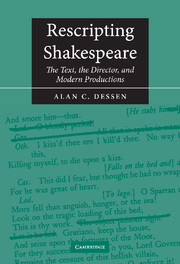Book contents
- Frontmatter
- Contents
- Acknowledgments
- Note on documentation
- List of abbreviations
- 1 “Let it be hid”: price tags, trade-offs, and economies
- 2 Rescripting Shakespeare's contemporaries
- 3 Adjustments and improvements
- 4 Inserting an intermission/interval
- 5 What's in an ending? Rescripting final scenes
- 6 Rescripting stage directions and actions
- 7 Compressing Henry VI
- 8 The tamings of the shrews: rescripting the First Folio
- 9 The editor as rescripter
- Conclusion: what's not here
- Appendix: productions cited
- Notes
- Index
4 - Inserting an intermission/interval
Published online by Cambridge University Press: 22 September 2009
- Frontmatter
- Contents
- Acknowledgments
- Note on documentation
- List of abbreviations
- 1 “Let it be hid”: price tags, trade-offs, and economies
- 2 Rescripting Shakespeare's contemporaries
- 3 Adjustments and improvements
- 4 Inserting an intermission/interval
- 5 What's in an ending? Rescripting final scenes
- 6 Rescripting stage directions and actions
- 7 Compressing Henry VI
- 8 The tamings of the shrews: rescripting the First Folio
- 9 The editor as rescripter
- Conclusion: what's not here
- Appendix: productions cited
- Notes
- Index
Summary
“the interim's mine”
Hamlet, 5.2.73Like most playgoers for years I paid little attention to the twin questions of (1) how many intermissions (US) or intervals (UK) a performance should have and (2) where they should be placed. A series of productions in 1989, however, made me conscious of the often tricky choices that a director must make. At the Oregon Shakespeare Festival I saw a strong production of All My Sons in which Miller's three acts were presented with only one break and an even stronger Cyrano in which Rostand's three scripted breaks for his four acts were reduced to two. At the National Theatre in London I then saw Speed the Plow with Mamet's two intervals reduced to one and Hedda Gabler with two intervals rather than Ibsen's scripted three. Then at the Pit I saw The Man of Mode with Etherege's three acts presented as two.
The rhythms of all five shows were changed, however slightly, by such adjustments, with the most notable consequences in Howard Davies's Hedda. If economy of presentation is the goal, the obvious choice in this four-act script would be to have one interval placed after Ibsen's Act 2, but, in order to set up some special effects (e.g., falling snow during a winter night while Hedda and Mrs. Elvsted awaited the return of Lovborg), Davies ran Acts 2 and 3 together, in the process causing confusion for some playgoers about the passage of time.
- Type
- Chapter
- Information
- Rescripting ShakespeareThe Text, the Director, and Modern Productions, pp. 94 - 108Publisher: Cambridge University PressPrint publication year: 2002



